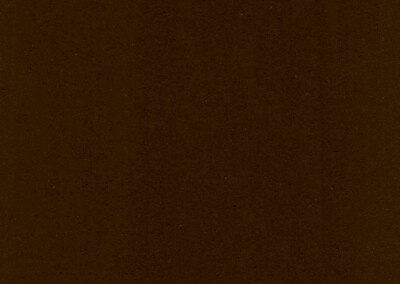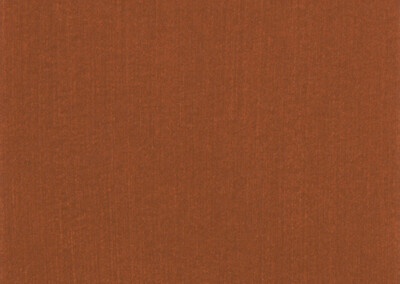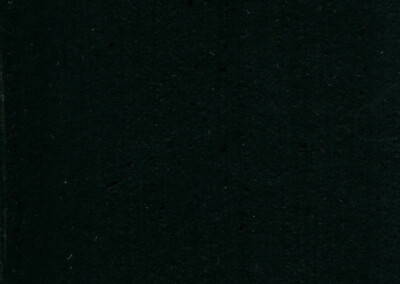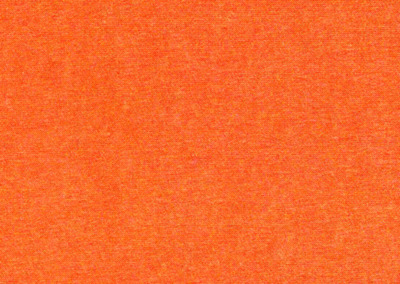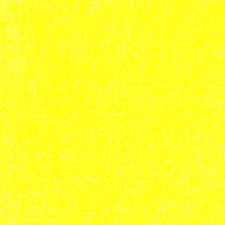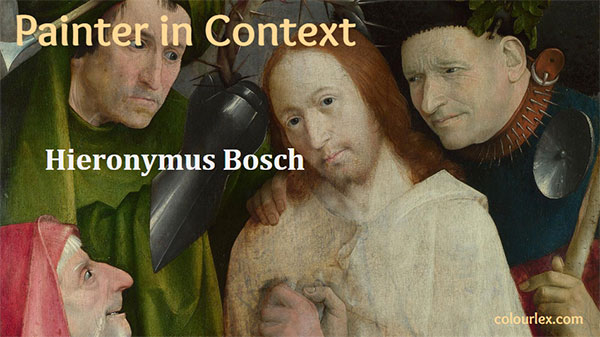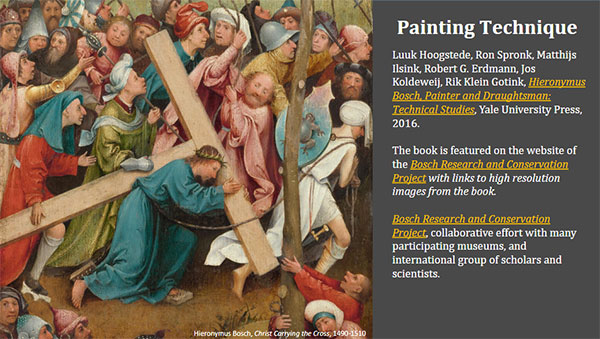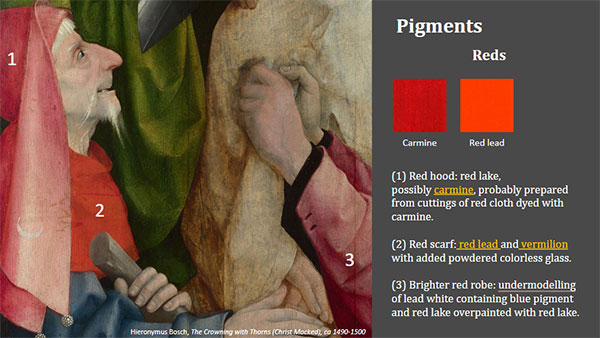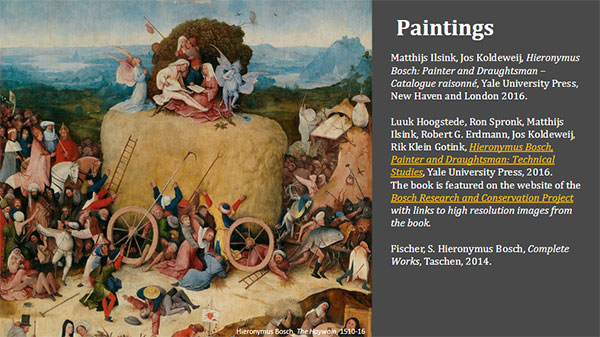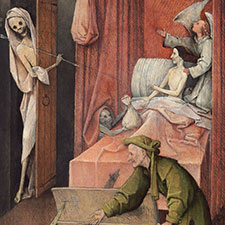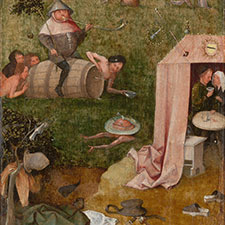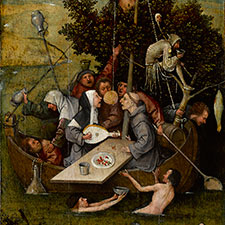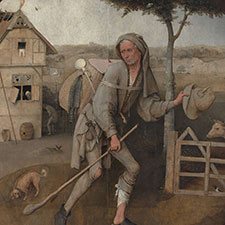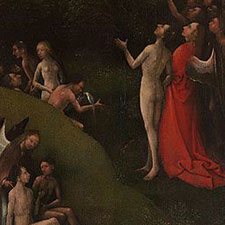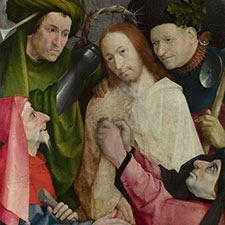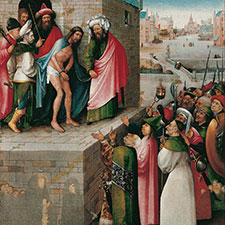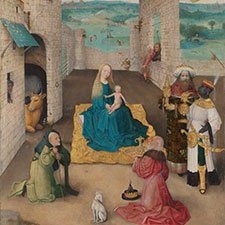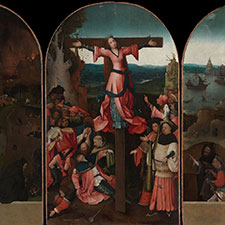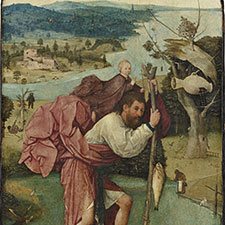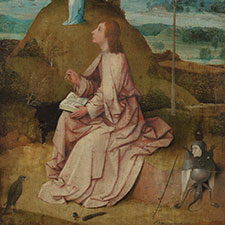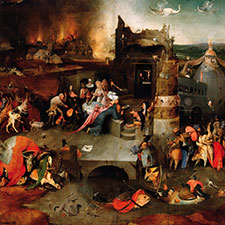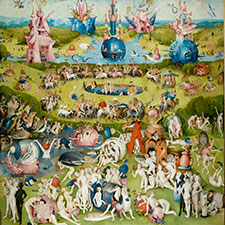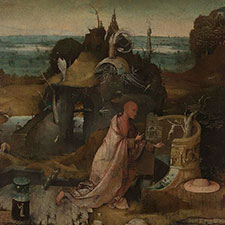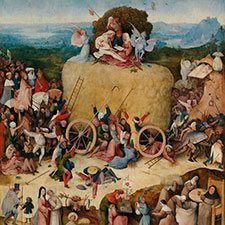Hieronymus Bosch, The Wayfarer
ca 1500-1510Paintings sorted by Historical period | Painter | Subject matter | Pigments used
Overview
‘The Wayfarer’ originally formed the two closed wings of a triptych and thus must have been originally rectangular in shape. It is not known when and in what circumstances the original triptych was dismantled. The other parts of the triptych were “The Ship of Fools” and its fragment “Gluttony and Lust” and “Death and the Miser“. The central panel was lost.
The painting was thoroughly investigated by The Bosch Research and Conservation Project. The results of this investigation were published in a magnificent book referenced in the section “Recommended Books” below. An extensive interactive online feature at the website of the project complements the book and shows all the images from the book in high resolution. The pigment analysis reveals a limited palette consisting of the usual pigments employed in the Renaissance period, such as lead-tin yellow, madder lake, and ochres.
Date: 1500-10
Medium: Oil
Support: Oak
Size: width : 70,6 cm, height : 71 cm, diameter : 64 cm
Art period: Renaissance
Museum Boijmans Van Beuningen, Rotterdam
Inventory number: 1079
Painting at the website of the BOSCH PROJECT
Pigments
Pigment Analysis
This pigment analysis is based on the work of the scientists at The Bosch Research and Conservation Project (1). The scientists employed X-ray radiography (XRR), infrared photography (IRP) and infrared reflectography (IRR) to gain insights into the inner layers of the painting and to identify the pigments.

1 Sky: lead white with some blue pigment.
2 Red contour: dense black underlayer covered by a layer of madder lake mixed with a little lead white, followed by a madder lake glaze with small amounts of orange inorganic pigment.

3 The foliage of the tree: brown base consisting of bone black, red ochre (?), and white. The foliage was indicated by small dabs of grey paint.
4 Bird hanging in the tree: the wings were painted with blue pigment with the addition of some grey, the belly contains lead-tin yellow.
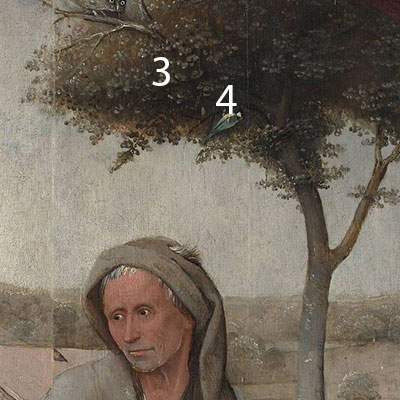
5 Brownish structure of the house: brown ochre and umber.
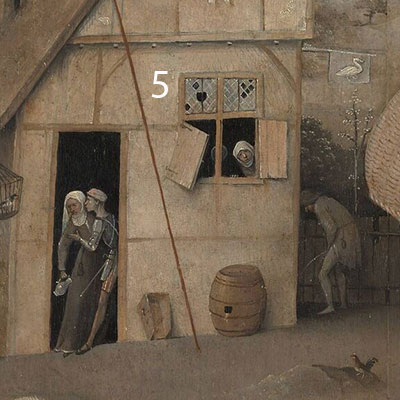
References
(1) Luuk Hoogstede, Ron Spronk, Matthijs Ilsink, Robert G. Erdmann, Jos Koldeweij, Rik Klein Gotink, Hieronymus Bosch, Painter and Draughtsman: Technical Studies, Yale University Press, 2016, pp. 264 – 275.
Pigments Used in This Painting
Resources
See the collection of online and offline resources such as books, articles, videos, and websites on Hieronymus Bosch in the section ‘Resources on Painters‘
PowerPoint Presentations
Painter in Context: Hieronymus Bosch
A richly illustrated presentation on the painting technique and pigments employed by Hieronymus Bosch specially crafted for Art Education. (Number of Slides = 20)
- Each presentation starts with the basic resources on the painter such as his biography, main catalogs of his paintings, and a bibliography.
- Next, you find slides describing the painting technique of the artist and the pigments he usually employed in his work.
- The majority of the slides show examples of paintings containing the specific pigments.
Slides showing the basic resources on the life and works of the Northern Renaissance painter Hieronymus Bosch.
The painting technique and all pigments employed by Bosch are shown in the next slides.
The majority of the slides show important examples of paintings where Bosch employed specific pigments. The slides are organized according to the color of the pigments.
Videos
Video: 'The Pedlar Close Up' by ARTtube
Publications and Websites
Publications
(1) Matthijs Ilsink, Jos Koldeweij, Hieronymus Bosch: Painter and Draughtsman – Catalogue raisonné, Yale University Press, New Haven and London 2016, pp 316-335.
This book is also available online in pdf format in two parts: part I and part II.
(2) Luuk Hoogstede, Ron Spronk, Matthijs Ilsink, Robert G. Erdmann, Jos Koldeweij, Rik Klein Gotink, Hieronymus Bosch, Painter and Draughtsman: Technical Studies, Yale University Press, 2016, pp. 264 – 275.
(3) Philip Leider, The Identity of Hieronymus Bosch’s Wayfarer, Department of Art History, University of California, Irvine.
(4) Yona Pinson, Hieronymus Bosch: Homo viator at a Crossroads: A New Reading of the Rotterdam tondo, Artibus et Historiae, Vol. 26, No. 52 (2005), pp. 57-84. DOI: 10.2307/20067097
(5) Eric De Bruyn, ‘Hieronymus Bosch’s So-called Prodigal Son Tondo: The Pedlar as a Repentant Sinner’, in Jos Koldeweij, Bernard Vermet and Barbara van Kooij (eds.), Hieronymus Bosch. New Insights into His Life and Work, Rotterdam 2001, pp. 133–44.
(6) Caspers, Charlotte. “A Historical Reconstruction of The Pedlar by Jersonimus Bosch.” InJheronimus Bosch: His Sources. Jheronimus Bosch Conference, 2nd: May 22-25, 2007, Jheronimus Bosch Art Center. ‘s-Hertogenbosch, 2010: 54-55, 69 nt. 23 and nt. 26, 153, color repros.
Websites
Website of the Bosch Project
Website of the Bosch Research and Conservation Project


